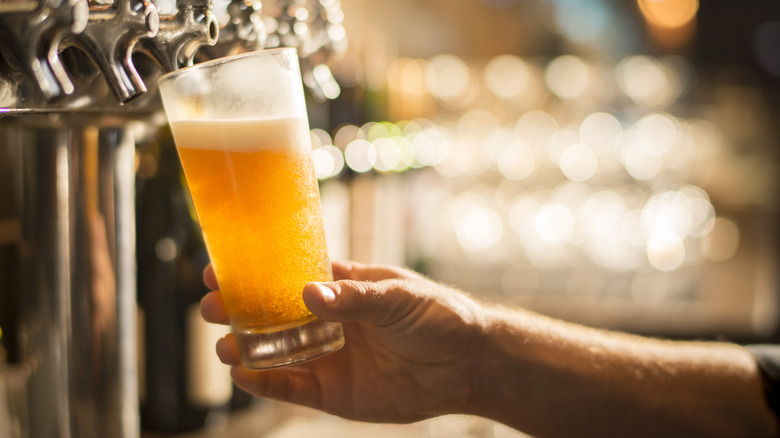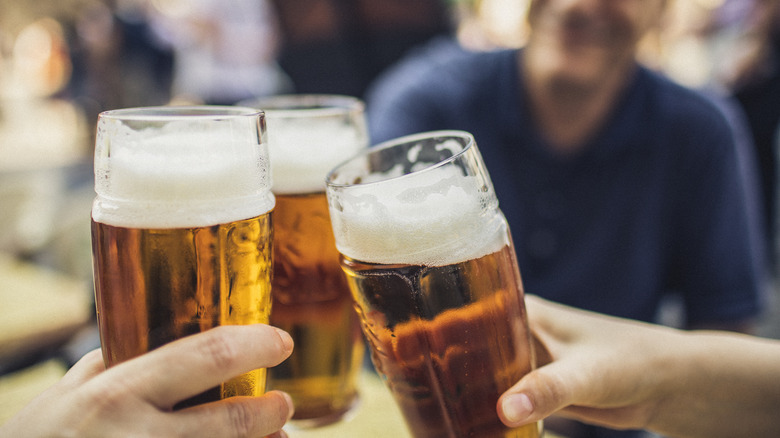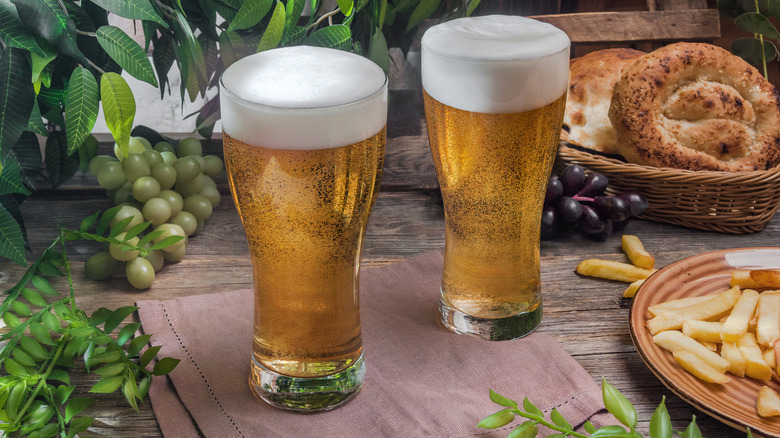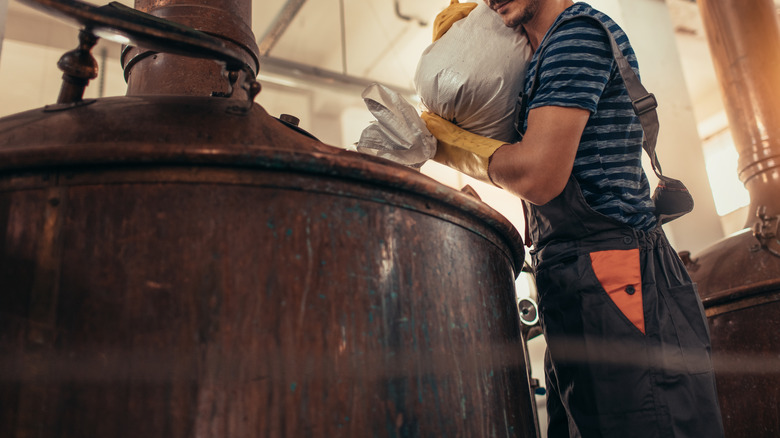The Exact Difference Between Lager And Pilsner Beers
If you're into home brewing or craft beers, then you've probably encountered the phrase "all pilsners are lagers, but not all lagers are pilsners." At first glance, it sounds wicked intimidating (or at least a little confusing), but in the same way that pinot noir is a red wine, but not all red wines are pinot noir, pilsner is just one style of beer within the broader lager category. Lagers are the most popular type of beer (and among the most commercially available) consumed in the world – and with their accessible taste and alcohol content (typically clocking in around a standard 4%-5% ABV), it's no mystery why. Lagers go down smoother than mealy IPAs, it's easier to drink a lot of them, and they're generally affordable for everyday enjoyment but still more elevated than mass-produced options like Coors or Busch Light (which is technically a light lager, but we still don't recommend it). So where do pilsners factor into the equation? And what exactly is the difference between these categories of beer?
The primary difference is that pilsners are just a more specific subtype of beer with a consistent profile, whereas the "lager" label encompasses a wide family of different beers. Visually, lagers can be anything from dark brown to amber or gold, while pilsners are always light with a bright straw-colored hue. On the palate, pilsners taste smooth, spicy, and malty, while the taste of other lagers can range from sweet and bready to bitter and nutty.
What is lager?
Instead of trying to define what a lager is, it's much easier to describe what a lager can be. Lager is a type of high-carbonation beer made from bottom-fermenting yeast at low temperatures, which is responsible for the beer's signature crisp, clean, refreshing profile. Beyond this common jumping-off point at the production level, lagers can vary in darkness, lightness, ABV, and flavor — as well as quality, with specialized craft beer companies and mass-scale brewing giants alike producing lagers. Among the most popular types of lagers are bock (dark, strong, not overly hoppy), dunkel (dark and smooth), helles (bright gold), märzen (robust, full-bodied), and Vienna (sweet, malty, bready), but these are only a few. According to the official Brewers Association, there are 35 recognized subcategories of lager (including pilsner).
Whether it's dark brown, golden, pale, nearly black, or reddish amber, a lager is still a lager. This beer category is all about range, and the taste can lean anywhere from sweet and bready to rich and roasted-nutty. Popular brands include Bud Light, Yuengling, Sapporo (one of the best Japanese beer brands available in the U.S.), Samuel Adams, Narragansett, Jack's Abby, Corona, Tecate, Modelo, and Great Lakes Dortmunder Gold.
Making crisp, clear lager is all about cold storage. Lager was first created sometime during the 1400s, and considering that this predates the advent of refrigeration by several hundred years, lager-making was originally a winter-exclusive activity, then stored through the summer months. This is why the word "lager" has etymological origins in the German "lagern," meaning "to store."
What is pilsner?
Pilsner is a pale lager beer with a characteristic golden hue and spicy flavor. They taste grainy and subtly sweet, with a crisp, dry mouthfeel and relatively low bitterness at 25-45 IBU – which is still significantly more bitter than most lagers at 5-25 IBU. Today, there are four main types of pilsner on the dominant market: American pilsner (sweet, bready, malty), Belgian pilsner (light and smooth), Czech pilsner (sweet, bready, aka Bohemian pilsner), and German pilsner (bitter, dark, hoppy). Other subcategories like Italian, Australian, New Zealand, and Mexican pilsners also enjoy a wide fan base.
Pilsner is named after its city of origin, Plzeň in the Czech Republic (a city every beer lover should consider visiting), where it was created by brewer Josef Groll during the 1800s. Groll developed pilsner's holy trinity formula: soft water, malty barley, and Saaz hops. Soon after the Bavarian brewer developed the beer, it found an enthusiastic fan base among the German people, who brought pilsner with them as they immigrated all around the world. The Czech brewery now known as Pilsner Urquell first released its eponymous pilsner in 1842, and it continues to crank out the beer today. Other popular brands include Beck's, Presidente, Labatt Blue, Krombacher Pils, Lagunitas Pils, Heineken, and Stella Artois. In the kitchen, we love pairing pilsner with pizza and using it to deglaze pork.
Pilsners are a more specialized, hoppy, spicy type of lager
As we've explored, the chief characteristics that distinguish pilsner from lager pertain to pilsner's more specific profile compared to wide-ranging lager. But to best understand what makes these same-family beer categories different, it's helpful to take a look at how they differ on the fundamental level of production. Pilsners are also made using "lagering" — which is a verb, and refers to bottom-fermenting yeast that thrives at cold temperatures. Lagering requires the yeast remain in the wort at the bottom of the fermentation tank for longer durations compared to warmer temperature brews like top-fermenting ales. Exact temperatures vary throughout the brewing process but tend to stay between 35 and 65 degrees Fahrenheit, held for around two full weeks.
But when it comes to brewing pilsner, attention to detail is crucial. Pilsners are made from lager yeast and a unique pilsner malt not shared by any other type of beer. For lagers, the specific strain of yeast is typically a hybrid of Saccharomyces cerevisiae and Saccharomyces eubayanus. Pilsner malts are made from lightly kilned two-row barley and hops called "noble hops," which are responsible for the beer's peppery, flowery, spicy profile. Hallertau, spalt, and saaz hops are common for making pilsners, while lagers can be made from a much wider selection of malts like Vienna, Munich, and Maris Otter, among others. Overall, the result is that pilsners are spicier, hoppier, a tad more bitter, and more full-bodied compared to clear, refreshing lagers.



